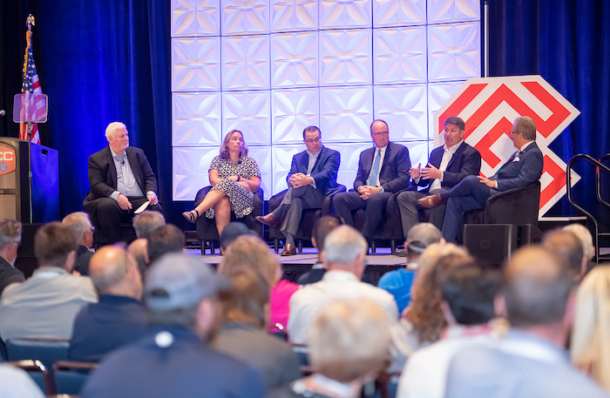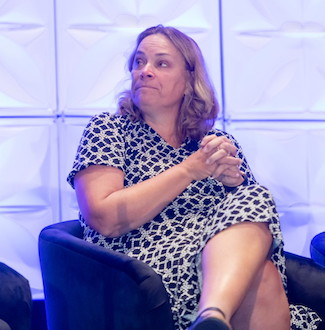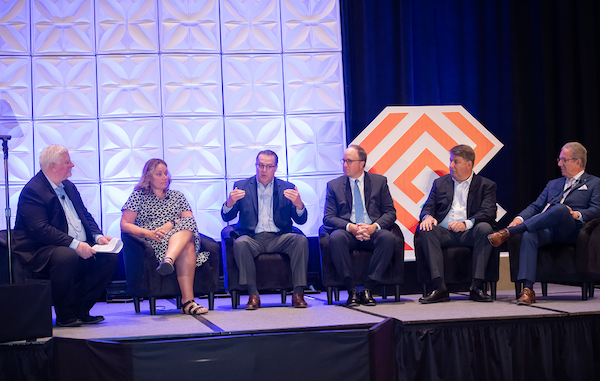Monumental concerns in the industry—from supply chain issues and inflation concerns to electrification and decarbonization—challenge contractors and manufacturers alike to be ready to rise above the fray.
On September 28, Hurricane Ian, a Category 4 storm, hit the Florida coast, leaving a trail of destruction, loss of life, and people without power, and a place to live. The following week, after the residual rains moved through the South Atlantic states, PHCC CONNECT attendees, exhibitors and staff were fortunate to convene in Charlotte, N.C. for the annual show.
One of the many bright spots during CONNECT was the annual Industry Perspective panel—back by popular demand—which featured some of the industry’s finest: Elisabeth Sutton, Director—Marketing, Professional Channel, Kitchen and Bath Americas, Kohler; Bruce Carnevale, President and CEO, Bradford White Corporation; Randy Roberts, Vice President of Sales and Marketing, Rheem; Scott Teson, Senior Vice President of Skilled Trades, Milwaukee Tool; Jeff Fetters, Chairman, Federated Insurance Companies.

As I prepared for the panel, I would have been remiss if I didn’t mention those people still struggling in the Sunshine State. And the more I thought about what was happening in Florida, the more I could draw some symmetry of what has been plaguing our nation the past few years.
Things like supply chain. Are the right people getting what they need in Florida? Labor shortage. Do we have the manpower to provide assistance? Or, do we have the proper infrastructure in place? What about electrification? I mean, I had just seen a meme that said something like, “2.8 million people without power, time to fire up the Teslas.” Now that could be perceived as a bit naïve, but when you look at California, for instance—declaring no new gas cars sold in the state by 2035—concerns about adequate infrastructure are real.

It’s a good thing we had the right people on the panel to address such concerns. I learned that Federated Insurance sent “catastrophic teams” to Florida to help. “We needed to have boots on the ground as quickly as we could,” said Fetters. “Businesses need to have high expectations for employees to remain safe. Disasters can strike at any time. A risk management culture has to perpetuate through every single employee,” said Fetters.
As a side note, how can contractors prepare for such an event? “Make sure you sit down with an agent to see what it would cost to replace your business, and any personal property in the event of any potential catastrophe,” said Fetters.
Supply Chain Woes
Nonetheless, supply chain issues dominate conversation almost daily among working contractors. “We are still challenged by supply chain issues, and it has forced us as a company to better manage our supply chain. We do things differently now,” said Carnevale.

As a manufacturer, you’re never getting what you need from plastic resins overseas, nickel component slowing lines down to component issue challenges,” said Roberts. “This makes us be creative on managing supply chain.”
According to Sutton, “We see that luxury side of remodeling is still high. The thing impacting supply chain is that distributors are receiving more products, managing inventory for distributors.”
Investments in People/Training
Milwaukee Tool has made an $400 million investment in domestic manufacturing. “We want to control our own destiny,” said Teson. Yet, Teson pointed out that with more commercial construction projects on the books, how do we find the right people to support those jobs? “We need skilled tradesmen and women to support those efforts,” said Teson.
Sutton suggests that technology in products is a viable avenue to attract the younger generation. C’mon, who doesn’t like the way an impact driver or press tool feels in their hands?

Elisabeth Sutton
“We also need to attract people to the industry to show them how wonderful it is, and that should not be specific to one type of person,” said Sutton. “We need more diversity, not just one profile,” continued Sutton.
“This is a fantastic industry, and once people are a part of it, they stay,” said Roberts.
Yet, once in the building, how do we get people to stay? Training. “It has always been a critical part of what we do. We have been very flexible with our training—we will take it to customers and also bring them into our facility,” said Carnevale.
How do employees continue to get better year after year? The panel agreed that it’s about establishing a culture of training in your office. This gives employers a competitive advantage in keeping people and attracting people because they will be seen as investing in them.
Electrification is the Buzzword
According to Carnevale, topics surrounding electrification loom large. For example, will the infrastructure be in place to support the new products? How will the infrastructure build out in a very short time? This puts the consumer in a bad position and puts our national security at risk—i.e., supply chain issues and the country’s fragile relationship with China.
“Electrification and decarbonization, whether we like it or not, we need to be prepared. We have the products available,” said Roberts.
Government Regulations
Carnevale noted that he receives email relating to a regulatory issue almost daily. “The DoE is extremely active, and there’s a requirement that is in the foundational law that once the DOE sets a new minimum efficiency standard, it cannot go backward.”

The panel consisted of (from l to r): John Mesenbrink, moderator; Elisabeth Sutton, Kohler; Bruce Carnevale, Bradford White; Randy Roberts, Rheem; Scott Teson, Milwaukee Tool; Jeff Fetters, Federated Insurance.
According to Rheem’s Roberts, there is an “Install Date Standard for Air Conditioning Systems” looming and, “Contractors will be breaking the law if they install an AC system not rated to the new standard come January, 1 2023.” Efficiency standards dictate that sell through of existing systems will be allowed in the northern states if the product was manufactured prior to January 1, 2023. This is not the case in the South and Southwest. AC systems must comply with the 2023 federal minimums to be installed after January 1, 2023. Current Heat Pump systems can continue to be installed in all regions as long as they were manufactured before January 1.
And who is enforcing this, you may ask? “Contractors and distributors will be self-policing installations to make sure they meet the new standard. In addition, manufacturers cannot ship products that don’t meet the new standards or allow them to be registered for warranties if installed after January 1. A standard based on install date will ultimately create inventory challenges for everyone in the industry,” said Roberts.
That Dreaded ‘R’ Word
There are whispers of the “R” word and I don’t think it means that “relief” is on the way anytime soon. From inflation to fuel prices, contractors have faced economic hardships that may continue to linger into 2023, and beyond. “We’ve been bearish on the economy longer than the financial press has been,” says Carnevale. “It is pretty clear that we are in a recession. There have been some positive signs, the fed is getting aggressive, and we will see significant drop in housing market.”
Carnevale continued that he is concerned about the macro economy, even though there are some good signs. “Labor shortages continue to be a vexing problem, and we need to focus on the labor participation rate compared to pre-pandemic, meaning there are a lot of people who are choosing not to work,” said Carnevale.
Teson said that interest rates are the real threat. “We’re watching it very closely and trying to make decisions that will make us come out stronger than our competitors.”
Carnevale added that there is a very distinct demand for discretionary vs. non-discretionary products. In the end, “As the demand starts to soften, we are subject to the laws of supply and demand. It is not going got back to where it is pre-pandemic, but will see some softening on pricing.”
Roberts says that overall, we should see a correction. “How do you position yourself to come out stronger than you go into it?” That’s the question.
For more info, visit PHCC.



